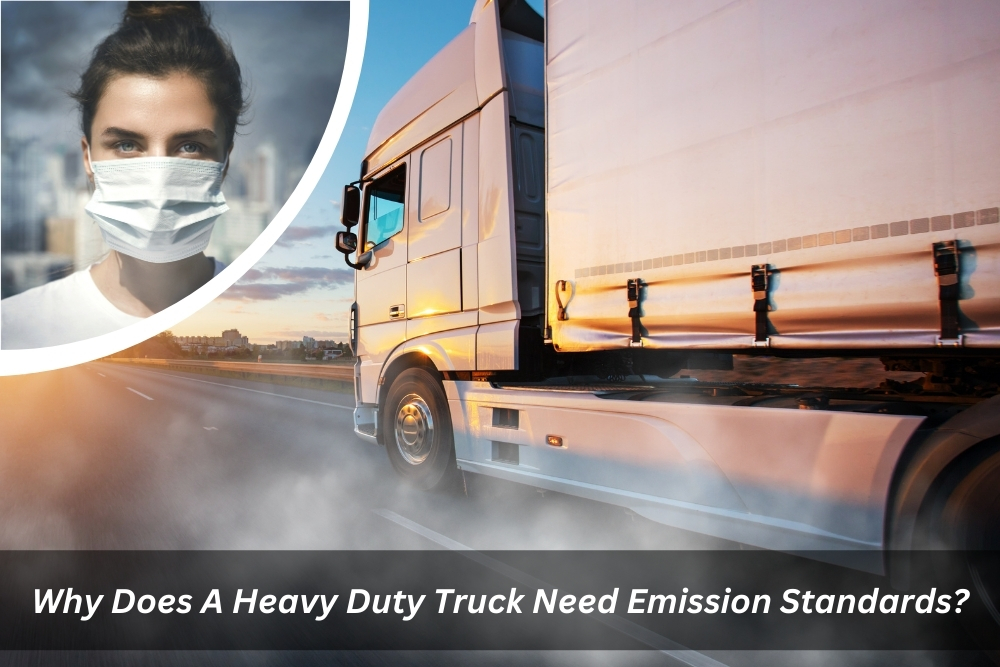Australia’s vast landscapes demand robust heavy-duty trucks to keep the wheels of industry turning. However, with great power comes great responsibility. In the modern world, where environmental concerns are at the forefront, heavy-duty trucks must adhere to stringent emission standards. In this article, we will delve into the world of emission standards, exploring their necessity, benefits, types, challenges, and solutions for ensuring your heavy-duty truck fleet meets these standards.
What are emissions standards and why are they necessary?
Emission standards, in essence, serve as vital guidelines established by regulatory authorities to control and restrict the emission of harmful pollutants into the environment, particularly from significant sources like heavy-duty trucks. Basically, these standards play a pivotal role in mitigating the adverse impacts of air pollution, safeguarding public health, and contributing to global efforts aimed at combatting climate change. By imposing limits on the release of pollutants, such as nitrogen oxides (NOx) and particulate matter, these regulations create a framework that promotes cleaner air quality and healthier living conditions for communities across Australia.
The necessity of emission standards becomes evident when considering their role as a protective shield for the delicate ecological balance of our ecosystems. Heavy-duty trucks, although essential for transporting goods and maintaining the flow of commerce, can potentially contribute to environmental degradation through the emission of pollutants. Emission standards act as a preventive measure, ensuring that these trucks operate within predefined limits, thereby reducing their overall environmental footprint. This not only safeguards the diverse flora and fauna of Australia but also supports the sustainability of our natural resources. In essence, emission standards embody a commitment to responsible and sustainable practices, fostering a harmonious coexistence between industrial activities and the environment we all share.
How do emission standards benefit your heavy duty truck fleet?
By adhering to emission standards, your heavy-duty truck fleet stands to gain significant advantages. Let’s explore how these standards contribute to the well-being of your trucks and the environment.
- Environmental impact: Emission standards play a crucial role in reducing the release of harmful pollutants such as nitrogen oxides (NOx) and particulate matter. This directly translates to cleaner air, benefiting not only the environment but also the communities your trucks traverse.
- Fuel efficiency: Compliance with emission standards often involves advancements in engine technology, which, in turn, enhances fuel efficiency. This not only lowers operational costs but also reduces your fleet’s overall carbon footprint.
- Regulatory compliance: Operating within emission standards ensures that your heavy-duty trucks comply with local, national, and international regulations. This not only avoids legal complications but also positions your business as environmentally responsible, a factor increasingly valued by consumers and partners.
What are different types of emission standards and how do they apply to your heavy duty truck?
Emission standards come in various forms, each addressing specific pollutants and engine types. Understanding these standards is pivotal in ensuring your heavy-duty trucks are on the right side of the regulatory fence.
- Euro Standards: Widely adopted globally, Euro standards categorise vehicles based on their emission levels. As an Aussie truck owner, you must be aware of the Euro standards applicable in Australia, ensuring your fleet aligns with the country’s regulations.
- Emission Control Systems: Your heavy-duty trucks may be equipped with various emission control systems, such as selective catalytic reduction (SCR) or diesel particulate filters (DPF). Familiarising yourself with these technologies is essential for proper maintenance and compliance.
- On-Board Diagnostics (OBD): OBD systems monitor the performance of emission-related components, alerting you to potential issues before they become major problems. Regular checks and maintenance of OBD systems are crucial to meet emission standards.
What are the challenges of complying with emission standards?
While emission standards offer numerous benefits, complying with them is not without its challenges. It’s essential to navigate these obstacles to ensure the continued success of your heavy-duty truck fleet.
- Cost implications: Upgrading heavy-duty trucks to meet stringent emission standards can incur significant costs. However, the initial investment is often outweighed by long-term savings in fuel efficiency and regulatory compliance.
- Technological complexity: Implementing advanced emission control technologies requires technical know-how. Ensuring your maintenance crew is well-trained and equipped to handle these complexities is crucial.
- Transition periods: Adapting to new emission standards can be challenging during transition periods. Planning ahead and gradually introducing compliant vehicles to your fleet can mitigate disruptions.
How can you ensure your heavy duty trucks meet emission standards?
Achieving and maintaining compliance with emission standards is a multifaceted task. Here’s a guide to help you navigate the path toward a greener and more sustainable heavy-duty truck fleet.
- Regular maintenance: Implement a stringent maintenance schedule for your trucks, focusing on emission control systems. Timely repairs and replacements can prevent issues from escalating, ensuring consistent compliance.
- Invest in training: Equip your staff with the necessary skills to understand and maintain emission control technologies. Regular training programs can enhance their capabilities and keep your fleet in top-notch condition.
- Strategic fleet planning: Consider a phased approach to fleet renewal, incorporating newer, more environmentally friendly models over time. This allows you to balance the financial impact while steadily improving your fleet’s overall compliance.
Conclusion
In the ever-evolving landscape of heavy-duty trucking, emission standards are not merely regulatory hurdles but crucial benchmarks for a sustainable future. By embracing these standards, your heavy-duty truck fleet not only minimises its environmental impact but also gains a competitive edge in a world that increasingly values eco-conscious practices. As you navigate the road ahead, remember that meeting emission standards is not just about compliance; it’s about steering your fleet towards a cleaner and more prosperous future.
Ready to steer your heavy-duty truck fleet toward a cleaner and more sustainable future? Look no further than Core Truck Driving School – your partner in navigating the road to compliance with emission standards.
As you’ve discovered in our comprehensive guide on emission standards for heavy-duty trucks, the road to sustainability begins with knowledge and action. At Core Truck Driving School, we’re not just about teaching you to navigate the highways; we’re committed to preparing you for a future where responsible trucking meets environmental consciousness.
Join us in revolutionising the trucking industry by enrolling in our cutting-edge training program. Learn the ins and outs of emission control technologies, stay ahead of evolving regulations, and become a driving force for positive change on the road.
Get in touch with us today and drive your career toward a greener and more sustainable future. Let’s navigate the roads responsibly, ensuring that your heavy-duty truck is not just a powerhouse on wheels but a beacon of environmental stewardship. Enrol now and be a part of the change that moves us all toward a cleaner, brighter tomorrow.


